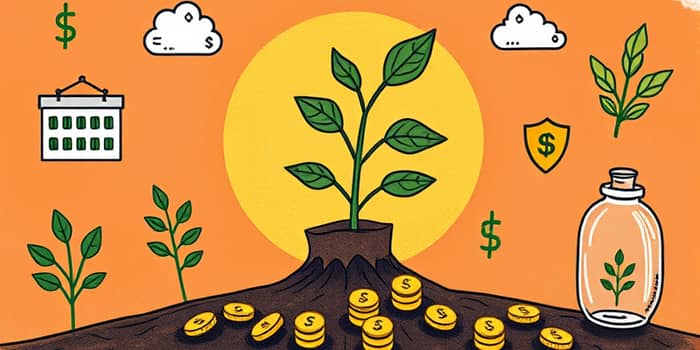
Achieving financial security and freedom requires more than just numbers; it demands a comprehensive mindset shift. This article explores how to manage money and integrate it with life goals, health, and happiness. By adopting a holistic perspective, readers will gain practical strategies and emotional support to thrive in their personal finances.
By weaving together practical guidance and personal stories, this guide equips you to build a resilient financial foundation and pursue meaningful goals. Whether you are just beginning or seeking to refine existing habits, the strategies laid out here can foster growth and confidence at every stage of life.
Financial wellness is defined as a state in which an individual can manage bills and expenses, pay off debts, withstand unexpected shocks, and plan for long-term objectives. The U.S. Consumer Financial Protection Bureau describes it as both financial security and freedom of choice, in the present and future. Present financial wellness allows control over daily and monthly outgoings without undue anxiety. Future wellness revolves around being on track for goals like retirement and college savings, granting the freedom to enjoy life with peace of mind.
This holistic approach recognizes that money is both a tool and a source of stress. It emphasizes proactive management rather than reactive crisis handling. By gaining clarity on cash flows and setting realistic benchmarks, individuals can move from uncertainty to a state of confidence and purposeful decision-making.
Foundational to this holistic model are four core elements that guide individuals toward lasting stability and growth. Each pillar builds on the last, creating a pathway from everyday spending to future prosperity. Financial literacy and education underpin all four pillars, empowering people to make informed decisions at every stage.
Effective budgeting ensures every dollar serves a purpose, often through zero-based methods that assign an allocation to each expense category. Establishing build an emergency fund by saving three to six months of living costs protects against income loss and unexpected bills. Managing debt focuses on reducing high-interest balances to free up cash flow and improve credit scores. Finally, starting small with regular investments harnesses the power of compounding returns for retirement and other goals.
Financial literacy and education are fundamental at every stage. Without a clear understanding of basic concepts—interest rates, credit scores, and investment vehicles—individuals may fall prey to high fees or predatory lending. Investing in knowledge pays dividends, creating a virtuous cycle of informed choices and improved outcomes.
Risk management is essential for safeguarding accumulated resources against catastrophic events. Adequate insurance—health, life, property, and disability—acts as a financial safety valve when crises strike. Without proper coverage, an unforeseen medical bill or property loss can erode years of diligent savings in a single incident. Integrating insurance planning with emergency savings provides a dual layer of security, ensuring that neither short-term shocks nor long-term liabilities derail the overall financial wellness strategy.
Alongside insurance, regularly reviewing policy terms and adjusting coverage ensures that protection keeps pace with life changes such as marriage, homeownership, or career shifts. Periodic risk assessments—evaluating personal health, property values, and liability exposures—help maintain optimal safeguards without unnecessary cost.
Money stress can significantly affect both mental and physical health, often leading to anxiety, depression, and chronic illness. Studies show that financial worry ranks among the top stressors for Americans, reducing productivity and undermining relationships. Conversely, achieving personal and subjective financial well-being fosters confidence and stability that resonate across all life areas. By addressing money matters proactively, individuals not only improve their bank accounts but also enhance their overall quality of life.
When financial worries diminish, individuals report better sleep, improved concentration, and more energy to pursue passions. Engaging in healthy money habits often inspires confidence in other domains—nutrition, exercise, and social relationships—highlighting the interconnectedness of holistic well-being.
Employers increasingly recognize that financially healthy employees are more engaged, focused, and productive. According to a recent survey, 57% of employees report financial stress, with two-thirds saying their anxiety has grown over the past year. Workplace programs offering budgeting workshops, access to professional advice, and automated savings plans help staff regain confidence and reduce distraction. On a broader scale, communities and campuses can integrate financial wellness into their health initiatives, emphasizing that money management is a key dimension of public well-being.
Public policy initiatives—like expanding financial education in schools and simplifying access to benefits—can amplify these workplace efforts at a societal level. By promoting transparency and reducing complexity, systems become more equitable and supportive of individual financial journeys.
Putting theory into practice is the key to lasting change. By following targeted steps, individuals can reclaim control over their finances and foster steady progress toward their dreams. Consistency and accountability are critical factors in sustaining momentum and measuring success over time.
Consistency is often the greatest challenge. Automating savings, debt payments, and even investment contributions reduces decision fatigue and builds momentum. Tracking progress with simple tools—spreadsheets, apps, or journal entries—fosters accountability and celebrates milestones.
Despite best intentions, many face obstacles on their journey to financial wellness. Lack of accessible education, mental health challenges tied to money anxiety, and structural inequalities can stall progress. Cultural attitudes that stigmatize debt or financial struggle often discourage open conversations and peer support. Recognizing these barriers is the first step toward dismantling them, as communities and individuals collaborate to create more inclusive pathways to prosperity.
Building supportive networks—peer groups, community classes, or online forums—can counteract isolation when tackling financial goals. Sharing successes and setbacks normalizes the journey and unlocks collective wisdom, turning individual challenges into shared opportunities for growth.
Consider the story of Maria, a young professional who started with student loans and minimal savings. By implementing a zero-based budget, she allocated every dollar toward priorities: housing, food, debt repayment, and a modest savings goal. Within two years, Maria eliminated high-interest credit card balances, built a three-month emergency fund, and began contributing to her employer’s retirement plan. Today, she feels confident navigating life’s uncertainties, knowing that her financial plan aligns with her values and ambitions.
Maria’s journey underscores the importance of adaptability. When her expenses shifted or interest rates fluctuated, she reviewed her budget, rebalanced her investments, and consulted mentors. This dynamic approach ensured that her plan remained aligned with her evolving values and life circumstances.
This example highlights how regular, disciplined investing over time can transform financial anxiety into empowerment. With each strategic decision, individuals like Maria reinforce positive habits that ripple through every aspect of their lives, paving the way for both material stability and emotional well-being.
References













